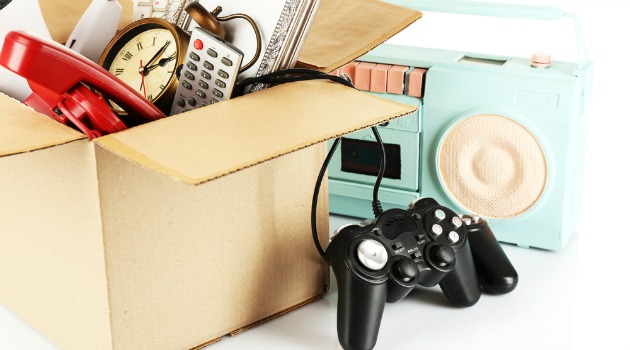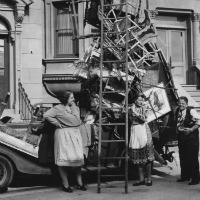Another week, another Tory MP sex scandal!

How to sell unwanted clutter on eBay

If you're finding yourself itching to declutter the house, but aren't keen on chucking perfectly good things away (or standing in the cold at a Saturday morning car boot sale), eBay may be your 'get out of jail free' card. Combine your seasonal cleaning with earning some cold hard cash and get rid of all your unwanted stuff at the same time. But how does it work? Is it as complicated as it looks? Read on for our guide to buying and selling on eBay, and watch the money roll in...
What is eBay? | Setting up your account | How to buy | How to sell | Creating a listing | Money, money, money | Postage | Keeping track of your items
What is eBay?
Known as "the world's online marketplace", eBay is the place where you can buy and sell almost anything, including clothes, toys for your grandchildren, antiques and even yachts <wishful thinking, we know>.
It's a quick and easy way to flog unwanted gifts old CDs, DVDs, books and all those items you've been hoarding in your loft since 1983. It's also a great place to find things you have always wanted or been meaning to replace, including items that are no longer available in the shops.
Setting up your account
Setting up your account is as easy as pie. Simply go to the eBay website, click 'register' in the top left-hand corner and fill in your details. You'll need to input your phone number to verify your account, as well as your bank details so that eBay can pay you when you've sold something. PayPal is the most common (and usually the simplest) way to pay for items and receive money for sold goods.
How to buy
eBay can be a great way to treat yourself to something new(...ish) and bag a bargain at the same time. When you've found something you like, it's worth browsing a variety of listings to see if other users are offering similar items for a lower price. The condition of the product, the price and the postage charge can vary enormously so look around the site to see if you can find it for a cheaper price or in better nick elsewhere!
Making purchases will also increase your feedback score and build up your reputation. When it comes to selling your own stuff, it helps if buyers can see that you've got a high rating.
Top tip: there are lots of items listed on eBay that are simply too big (or too expensive) to post and require buyers to collect them. If you're looking at something that falls into this category, check the seller's location. You don't want to be in the position of finding you've bought a large table in Aberystwyth when you live in London <blush>.
How to sell

Whether it's a brand new jumper complete with its original tag or an old teapot that you suspect no one would be interested in (it's amazing what sells), it's worth sifting through all your unwanted items. Search for the item you're planning to sell and have a nosey at other people's listings. Look out for how much they've listed their item for, the description and the keywords they have used. It's also worth checking what they're charging for postage. If you're not sure whether your item can be sold, check eBay's prohibited items list first.
Creating a listing
Do you want to have a fixed price for your item or sell it as you would in an auction? Buy-It-Now (which incurs an extra charge) might be best if you're selling valuable items, but auctions tend to gather more interest. Keep an eye on your inbox for emails from eBay - they often send notifications for 'no insertion fee' weekends.
How long do you want your listing to stay on the site for? eBay provides four standard options; three, five, seven or 10 days. Make sure your description is honest, including any imperfections your item may have. Do include a picture of any damage or wear, even if it's just a scratch, as often buyers assume the worst. Your listing should be specific, so include a brand name (if applicable), the item's condition (new or used), and any other details such as: model number, size, dimensions, style and colour.
Before your listing goes live, think about the timing. If you're going for an auction-style listing, you might have buyers swooping in at the last minute. That's unlikely to happen if your auction is set to end at 3am. The best time to aim for is somewhere between 7-10pm (although preferably not in the middle of The Great British Bake Off).
Money, money, money

Fees vary depending on your starting price, but it's usually no more than £1.30, depending on your item (you may not be so lucky if you happen to be selling your car). If your starting price is 99p or lower, your first 100 single quantity auction-style listings in a calendar month won't be charged an insertion fee - hurrah!
There are also final value fees to think about, which work out at 10% of the value of the total transaction (up to a maximum of £75 and not including properties). Another thing to bear in mind is that PayPal charge sellers 3.4% of the amount paid (including your postage amount), plus 20p per transaction.
But don't be put off. The rest of the money is yours and will be transferred directly to your PayPal account, unless you've specified another method of payment, ready to be put to good use on something lovely (weekend break, anyone?).
Postage
You need to pitch your delivery charges high enough to cover costs, but not so high that it puts people off! First, work out how much postage will cost by using eBay's postage estimator. Royal Mail also offers a useful guide. PayPal includes the amount you've set for postage when calculating your PayPal fees, so make sure you don't lose out. Don't forget to factor in the cost of packaging materials, such as envelopes, Jiffy bags and Sellotape.
It's perfectly acceptable to reuse packaging materials to keep costs down. But if the item is delicate, do make sure you wrap it properly. As the seller, you are liable for making sure it arrives in one piece. If you are sending items by regular (rather than recorded) delivery, always make sure you get proof of postage. There is no charge for this, but it can be very handy if your package somehow goes astray. And if your item is small, why not consider opening it to a wider market and listing internationally?
Keeping track of your items
You can keep track of the items you're selling or items you're bidding on by clicking 'My eBay' at the top right-hand corner of the eBay homepage.
Once you've sold your item, you'll also be able to see if the buyer has made the payment and left any feedback. Once you've sent your product, you can mark it as dispatched and leave feedback for the buyer.
Now...go forth and prosper!
Images: Shutterstock

